Thermo-Economic Comparison and Parametric Optimizations among Two Compressed Air Energy Storage System Based on Kalina Cycle and ORC
Abstract
:1. Introduction
- (a)
- In this paper, two novel combined CAES systems which have never been presented are proposed.
- (b)
- Compared with ACAES, the thermal storage vessel is not employed in the proposed system. In addition, the output power of the system can increase with the increasing power demand of the electric network.
- (c)
- The heat produced during the charging and discharging stage is used to generate electricity, which can improve the operation efficiency.
2. System Description
3. Mathematical Modeling
- (1)
- The air is treated as an ideal gas in the CAES system;
- (2)
- Ambient air is composed of 78.12% nitrogen, 20.96% oxygen and 0.92% argon;
- (3)
- The temperature and pressure of ambient atmospheric environment are 298.15 K and 101.325 kPa, respectively;
- (4)
- The fuel of the gas engine is composed of 100% methane;
- (5)
- In the KC and ORC, the working fluid in the condenser is cooled by water coming from the atmospheric environment.
3.1. CAES Mathematical Model
3.1.1. Turbine and Compressor
3.1.2. Gas Engine
3.1.3. Air Storage Vessel
3.2. ORC and KC Mathematical Model
3.2.1. Turbine and Pump
3.2.2. Mixer, Separator and Diverter
3.3. Heat Exchanger Model
3.4. Exergy Model of Systems
3.5. Performance Evaluation Criteria
4. Results and Discussions
4.1. Sensitivity Analysis
4.2. Parameter Optimization of Systems Based on the Genetic Algorithm
5. Conclusions
- (1)
- Firstly, increasing the pressure ratio of the compressor, the exergy efficiency and round-trip efficiency of the two energy systems decrease, resulting in the operation performance of the systems become worse. Secondly, the effect of the temperature of exhaust gas on KC-CAES is more obvious than that of the ORC-CAES; the KC-CAES system possesses higher operation efficiency and a lower heat rate, which illustrates that the Kalina cycle is more suitable as a heat recovery cycle of the CAES system.
- (2)
- For ORC-CAES, due to the changes in the total investment cost per total output power (ICPP) being relatively slow when the efficiency is less than 53.56%, the ICPP increases significantly when the efficiency is more than 53.56%; the optimal solutions around exergy efficiency of 53.56% are suggested for industrial applications. Moreover, the exergy efficiency value of 59.74% has been selected for the KC-CAES system as the final optimal solution, which is based on the design point in the Pareto front having the shortest distance from the hypothetical point.
Acknowledgments
Author Contributions
Conflicts of Interest
Abbreviations
| area of components (m2) | |
| channel spacing (m) | |
| boiling number | |
| capital cost | |
| specific heat capacity at constant pressure (J/kg·K) | |
| exergy (kJ) | |
| mass velocity | |
| enthalpy (kJ/kg) | |
| heat transfer coefficient (W/m2·K) | |
| isentropic exponent | |
| constant | |
| average distance between the channel (m) | |
| lower heating value (J/kg) | |
| flow rate (kg/s) | |
| number of channel | |
| Nusselt number | |
| pressure (pa) | |
| Prandtl number | |
| Reynolds number | |
| universal gas constant (J/kg·K) | |
| temperature (K) | |
| overall heat transfer coefficient (W/m2·K) | |
| volume of components (m3) | |
| power (kW) | |
| mass fraction of ammonia | |
| Greek letters | |
| β | chevron angle |
| δ | thickness of the plate (m) |
| ε | exergy efficiency |
| η | round-trip efficiency |
| λ | thermal conductivity of fluid (W/m·K) |
| μ | dynamic viscosity (N·s/m2) |
| π | pressure ratio |
| ρ | density (kg/m3) |
| Subscripts and superscripts | |
| ch | chemical |
| cold | cold fluid |
| Comp | compressor |
| Con | condenser |
| Div | diverter |
| eg | exhaust gas |
| Eva | evaporator |
| GE | gas engine |
| Hhex | high pressure regenerator |
| hot | hot fluid |
| HRC | heat recovery cycle |
| in | input of the system |
| ix | material stream |
| jx | chemical components |
| K | Kalina cycle |
| Lhex | low pressure regenerator |
| O | ORC |
| out | output of the system |
| P | product |
| ph | physical |
| PS | proposed system |
| Pum | pump |
| s | isentropic |
| tot | total |
| Tur | turbine |
| x | percentage of components |
Appendix A
| Components | Investment Model (k$) |
|---|---|
| Air turbine, Tur | [49,50] |
| Compressor, C1 or C2 | [49,50] |
| Regenerator, Reg | [49] |
| Gas engine, GE | [48] |
| Air storage vessel | [49] |
References
- Wolf, D.; Budt, M. LTA-CAES—A low-temperature approach to Adiabatic Compressed Air Energy Storage. Appl. Energy 2014, 125, 158–164. [Google Scholar] [CrossRef]
- Dudiak, J.; Kolcun, M. Integration of renewable energy sources to the power system. In Proceedings of the 14th International Conference on Environment and Electrical Engineering (EEEIC), Krakow, Poland, 10–12 May 2014.
- De Bosio, F.; Verda, V. Thermoeconomic analysis of a Compressed Air Energy Storage (CAES) system integrated with a wind power plant in the framework of the IPEX Market. Appl. Energy 2015, 152, 173–182. [Google Scholar] [CrossRef]
- Yao, E.; Wang, H.; Liu, L.; Xi, G. A Novel Constant-Pressure Pumped Hydro Combined with Compressed Air Energy Storage System. Energies 2015, 8, 154–171. [Google Scholar] [CrossRef]
- Yao, E.; Wang, H.; Wang, L.; Xi, G.; Maréchal, F. Thermo-economic optimization of a combined cooling, heating and power system based on small-scale compressed air energy storage. Energy Convers. Manag. 2016, 118, 377–386. [Google Scholar] [CrossRef]
- Tessier, M.J.; Floros, M.C.; Bouzidi, L.; Narine, S.S. Exergy analysis of an adiabatic compressed air energy storage system using a cascade of phase change materials. Energy 2016, 106, 528–534. [Google Scholar] [CrossRef]
- Zhang, Y.; Yang, K.; Li, X.; Xu, J. The thermodynamic effect of thermal energy storage on compressed air energy storage system. Renew. Energy 2013, 50, 227–235. [Google Scholar] [CrossRef]
- Zhao, P.; Wang, J.; Dai, Y. Thermodynamic analysis of an integrated energy system based on compressed air energy storage (CAES) system and Kalina cycle. Energy Convers. Manag. 2015, 98, 161–172. [Google Scholar] [CrossRef]
- Grazzini, G.; Milazzo, A. Thermodynamic analysis of CAES/TES systems for renewable energy plants. Renew. Energy 2008, 33, 1998–2006. [Google Scholar] [CrossRef]
- Arabkoohsar, A.; Machado, L.; Farzaneh-Gord, M.; Koury, R.N.N. Thermo-economic analysis and sizing of a PV plant equipped with acompressed air energy storage system. Renew. Energy 2015, 83, 491–509. [Google Scholar] [CrossRef]
- Arabkoohsar, A.; Machado, L.; Farzaneh-Gord, M.; Koury, R.N.N. The first and second law analysis of a grid connected photovoltaic plant equipped with a compressed air energy storage unit. Energy 2015, 87, 212–214. [Google Scholar] [CrossRef]
- Simpore, S.; Garde, F.; David, M.; Marc, O.; Castaing-Lasvignottes, J. Design and Dynamic Simulation of a Compressed Air Energy Storage System (CAES) Coupled with a Building, an Electric Grid and a Photovoltaic Power Plant. Clima 2016, 4, 1–11. [Google Scholar]
- Abbaspour, M.; Satkin, M.; Mohammadi-Ivatloo, B.; Hoseinzadeh Lotfi, F.; Noorollahi, Y. Optimal operation scheduling of wind power integrated with compressed air energy storage (CAES). Renew. Energy 2013, 51, 53–59. [Google Scholar] [CrossRef]
- Zhao, P.; Wang, M.; Wang, J.; Dai, Y. A preliminary dynamic behaviors analysis of a hybrid energy storage system based on adiabatic compressed air energy storage and flywheel energy storage system for wind power application. Energy 2015, 84, 825–839. [Google Scholar] [CrossRef]
- Fu, Z.; Lu, K.; Zhu, Y. Thermal System Analysis and Optimization of Large-Scale Compressed Air Energy Storage (CAES). Energies 2015, 8, 8873–8886. [Google Scholar] [CrossRef]
- Bouman, E.A.; Øberg, M.M.; Hertwich, E.G. Environmental impacts of balancing offshore wind power with compressed air energy storage (CAES). Energy 2016, 95, 91–98. [Google Scholar] [CrossRef] [Green Version]
- Gulagi, A.; Aghahosseini, A.; Bogdanov, D.; Breyer, C. Comparison of the Potential Role of Adiabatic Compressed Air Energy Storage (A-CAES) for a Fully Sustainable Energy System in a Region of Significant and Low Seasonal Variations. In Proceedings of the International Renewable Energy Storage Conference, Düsseldorf, Germany, 15–17 March 2016.
- Ibrahim, H.; Younès, R.; Ilinca, A.; Dimitrova, M.; Perron, J. Study and design of a hybrid wind–diesel-compressed air energy storage system for remote areas. Appl. Energy 2010, 87, 1749–1762. [Google Scholar] [CrossRef]
- Nielsen, R.F.; Haglind, F.; Larsen, U. Design and modeling of an advanced marine machinery system including waste heat recovery and removal of sulphur oxides. Energy Convers. Manag. 2014, 85, 687–693. [Google Scholar] [CrossRef]
- Basbous, T.; Younes, R.; Ilinca, A.; Perron, J. Optimal management of compressed air energy storage in a hybrid wind-pneumatic-diesel system for remote area’s power generation. Energy 2015, 84, 267–278. [Google Scholar] [CrossRef]
- Bombarda, P.; Invernizzi, C.M.; Pietra, C. Heat recovery from Diesel engines: A thermodynamic comparison between Kalina and ORC cycles. Appl. Therm. Eng. 2010, 30, 212–219. [Google Scholar] [CrossRef]
- Lecompte, S.; Huisseune, H.; van den Broek, M.; Vanslambrouck, B.; De Paepe, M. Review of organic Rankine cycle (ORC) architectures for waste heat recovery. Renew. Sustain. Energy Rev. 2015, 47, 448–461. [Google Scholar] [CrossRef]
- Dai, Y.; Wang, J.; Gao, L. Parametric optimization and comparative study of Organic Rankine Cycle (ORC) for low grade waste heat recovery. Energy Convers. Manag. 2008, 50, 576–582. [Google Scholar] [CrossRef]
- Yang, K.; Zhang, H.; Wang, Z.; Zhang, J.; Yang, F.; Wang, E.; Yao, B. Study of zeotropic mixtures of ORC (organic Rankine cycle) under engine various operating conditions. Energy 2013, 58, 494–510. [Google Scholar] [CrossRef]
- Yari, M.; Mehr, A.S.; Zare, V.; Mahmoudi, S.M.S.; Rosen, M.A. Exergoeconomic comparison of TLC (trilateral Rankine cycle), ORC (organic Rankine cycle) and Kalina cycle using a low grade heat source. Energy 2015, 83, 712–722. [Google Scholar] [CrossRef]
- Kim, Y.M.; Shin, D.G.; Favrat, D. Operating characteristics of constant-pressure compressed air energy storage (CAES) system combined with pumped hydro storage based on energy and exergy analysis. Energy 2011, 36, 6220–6233. [Google Scholar] [CrossRef]
- Wang, M.; Wang, J.; Zhao, P.; Dai, Y. Multi-objective optimization of a combined cooling, heating and power system driven by solar energy. Energy Convers. Manag. 2015, 89, 289–297. [Google Scholar] [CrossRef]
- Wang, J.; Yan, Z.; Wang, M.; Ma, S.; Dai, Y. Thermodynamic analysis and optimization of an (organic Rankine cycle) ORC using low grade heat source. Energy 2013, 49, 356–365. [Google Scholar] [CrossRef]
- Wang, J.; Yan, Z.; Wang, M.; Li, M.; Dai, Y. Multi-objective optimization of an organic Rankine cycle (ORC) for low grade waste heat recovery using evolutionary algorithm. Energy Convers. Manag. 2013, 71, 146–158. [Google Scholar] [CrossRef]
- Guo, Z.Y.; Liu, X.B.; Tao, W.Q.; Shah, R.K. Effectiveness–thermal resistance method for heat exchanger design and analysis. Int. J. Heat Mass Transf. 2010, 53, 2877–2884. [Google Scholar] [CrossRef]
- Guo, J.; Xu, M.; Cheng, L. The application of field synergy number in shell-and-tube heat exchanger optimization design. Appl. Energy 2009, 86, 2079–2087. [Google Scholar] [CrossRef]
- García-Cascales, J.R.; Vera-García, F.; Corberán-Salvador, J.M.; Gonzálvez-Maciá, J. Assessment of boiling and condensation heat transfer correlations in the modelling of plate heat exchangers. Int. J. Refrig. 2007, 30, 1029–1041. [Google Scholar] [CrossRef]
- Coletti, F. Heat Exchanger Design Handbook; Begell House: Danbury, CT, USA, 2016. [Google Scholar]
- Biematht, R.W.; Soane, D.S. Department of Chemical Engineering. Am. Chem. Soc. 2011, 115, 1394–1402. [Google Scholar]
- Zhang, X.; He, M.; Zhang, Y. A review of research on the Kalina cycle. Renew. Sustain. Energy Rev. 2012, 16, 5309–5318. [Google Scholar] [CrossRef]
- Yin, J.L.; Wang, D.Z.; Kim, Y.; Lee, Y. A hybrid energy storage system using pump compressed air and micro-hydro turbine. Renew. Energy 2014, 65, 117–122. [Google Scholar] [CrossRef]
- Oldenburg, C.M.; Pan, L. Porous Media Compressed-Air Energy Storage (PM-CAES): Theory and Simulation of the Coupled Wellbore–Reservoir System. Transp. Porous Med. 2013, 97, 201–221. [Google Scholar] [CrossRef]
- Pei, P.; Korom, S.F.; Ling, K.; He, J.; Gil, A. Thermodynamic impact of aquifer permeability on the performance of a compressed air energy storage plant. Energy Convers. Manag. 2015, 97, 340–350. [Google Scholar] [CrossRef]
- Vongmanee, V. The renewable energy applications for uninterruptible power supply based on compressed air energy storage system. In Proceedings of the IEEE Symposium on Industrial Electronics and Applications, Kuala Lumpur, Malaysia, 4–6 October 2009; pp. 827–830.
- Kemble, S.; Manfrida, G.; Milazzo, A.; Buffa, F.; Kemble, S.; Buffa, F. Thermoeconomics of a ground-based CAES plant for peak-load energy production system. J. Nanosci. Nanotechnol. 2016, 32, 1–16. [Google Scholar]
- Zavattoni, S.A.; Barbato, M.C.; Pedretti, A.; Zanganeh, G.; Steinfeld, A. High Temperature Rock-bed TES System Suitable for Industrial-scale CSP Plant—CFD Analysis Under Charge/Discharge Cyclic Conditions. Energy Proced. 2014, 46, 124–133. [Google Scholar] [CrossRef]
- Kirn, Y.M.; Favrat, D. Energy and exergy analysis of a micro-compressed air energy storage and air cycle heating and cooling system. Energy 2010, 35, 213–220. [Google Scholar]
- Singh, O.K.; Kaushik, S.C. Energy and exergy analysis and optimization of Kalina cycle coupled with a coal fired steam power plant. Appl. Therm. Eng. 2013, 51, 787–800. [Google Scholar] [CrossRef]
- Fu, W.; Zhu, J.; Zhang, W.; Lu, Z. Performance evaluation of Kalina cycle subsystem on geothermal power generation in the oilfield. Appl. Therm. Eng. 2013, 54, 497–506. [Google Scholar] [CrossRef]
- Fwa, T.F.; Chan, W.T.; Tan, C.Y. Genetic-Algorithm Programming of Road Maintenance and Rehabilitation. J. Transp. Eng. 1996, 122, 246–253. [Google Scholar] [CrossRef]
- Yang, M.D.; Chen, Y.P.; Lin, Y.H.; Ho, Y.F.; Lin, J.Y. Multiobjective optimization using nondominated sorting genetic algorithm-II for allocation of energy conservation and renewable energy facilities in a campus. Energy Build. 2016, 122, 120–130. [Google Scholar] [CrossRef]
- Atrens, A.D.; Gurgenci, H.; Rudolph, V. Economic Optimization of a CO2—Based EGS Power Plant. Energy Fuel 2011, 25, 3765–3775. [Google Scholar] [CrossRef]
- Li, H. Environomic Modeling and Multi-Objective Optimisation of Integrated Energy Systems for Power and Cogeneration. Ph.D Thesis, École Polytechnique Fédérale de Lausanne, Zurich, Switzerland, 2006. [Google Scholar]
- Couper, J.R.; Penney, W.R.; Fair, J.R.; Walas, S.M. Chemical Process Equipment, 2nd ed.; Gulf Professional Publishing: Houston, TX, USA, 2009. [Google Scholar]
- Ulrich, G.D. A Guide to Chemical Engineering Process Design and Economics; Wiley: New York, NY, USA, 1984. [Google Scholar]

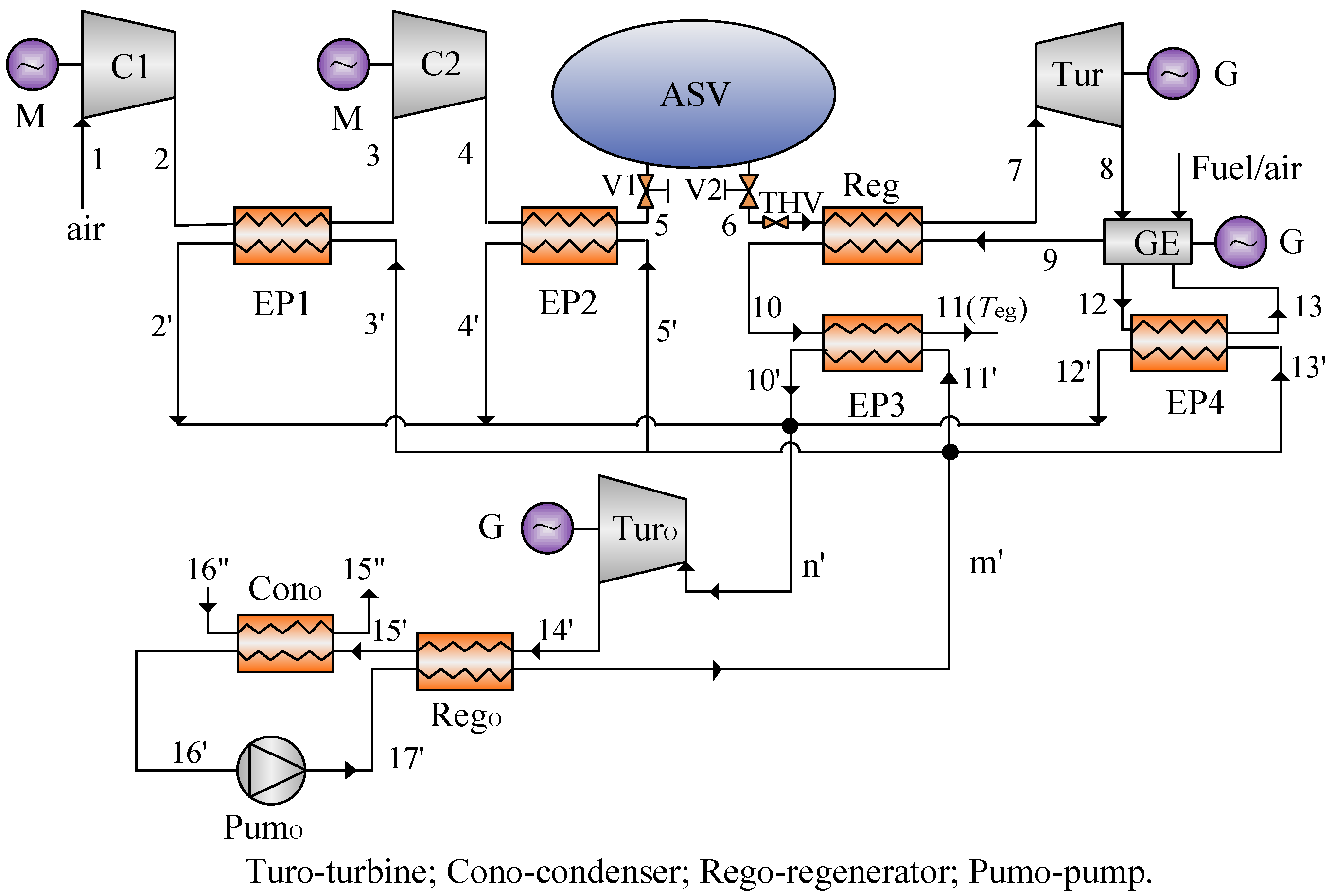
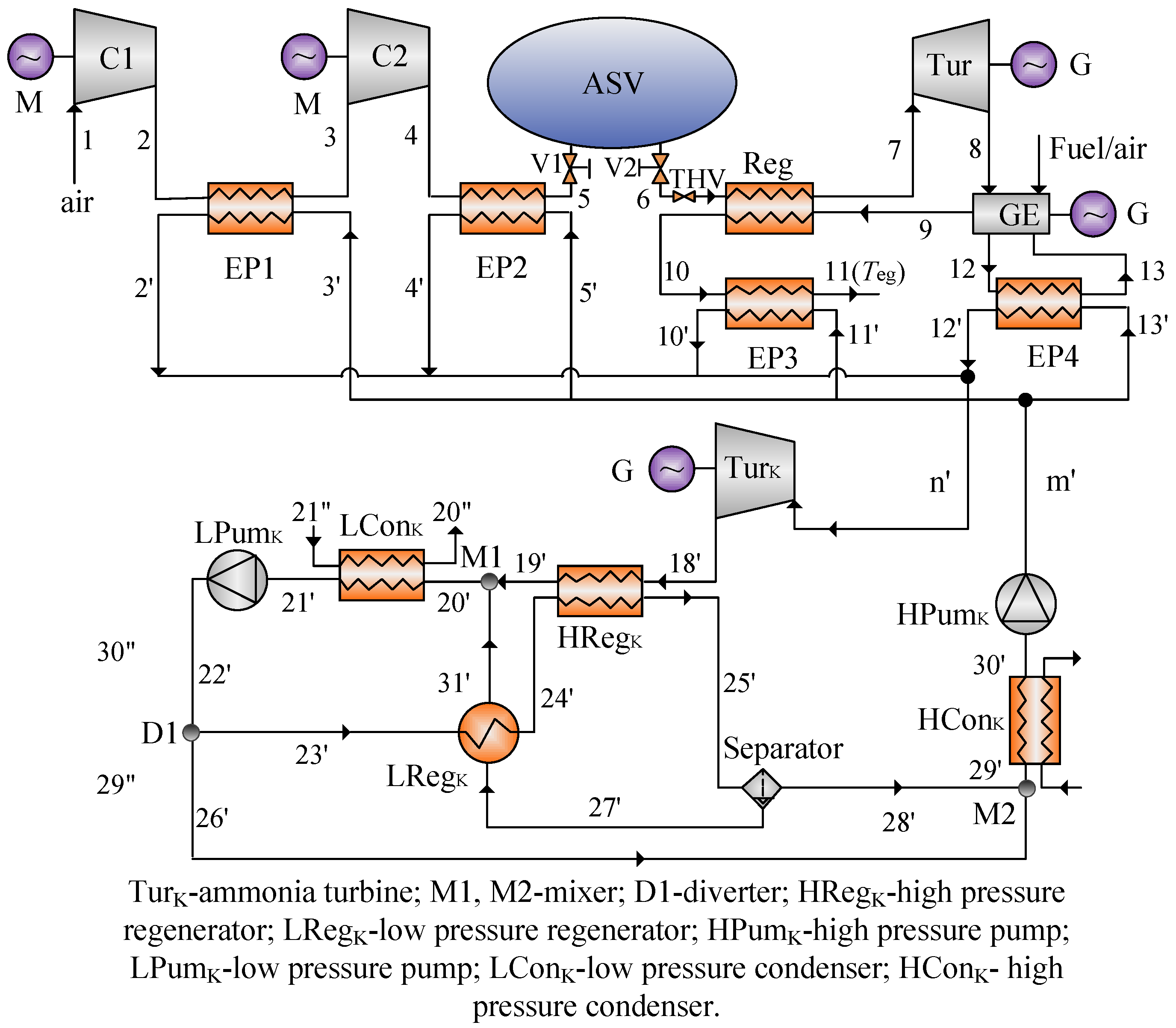
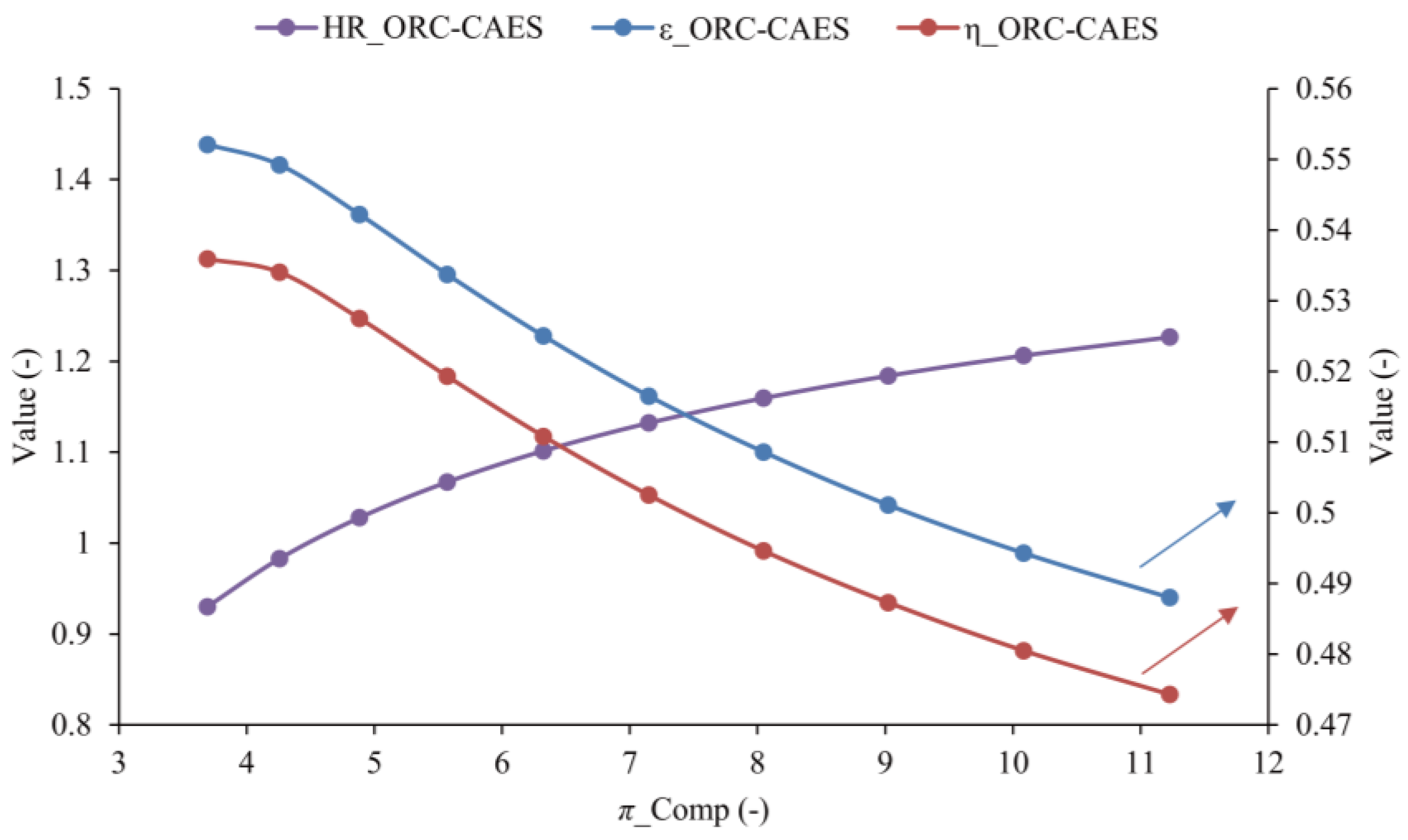
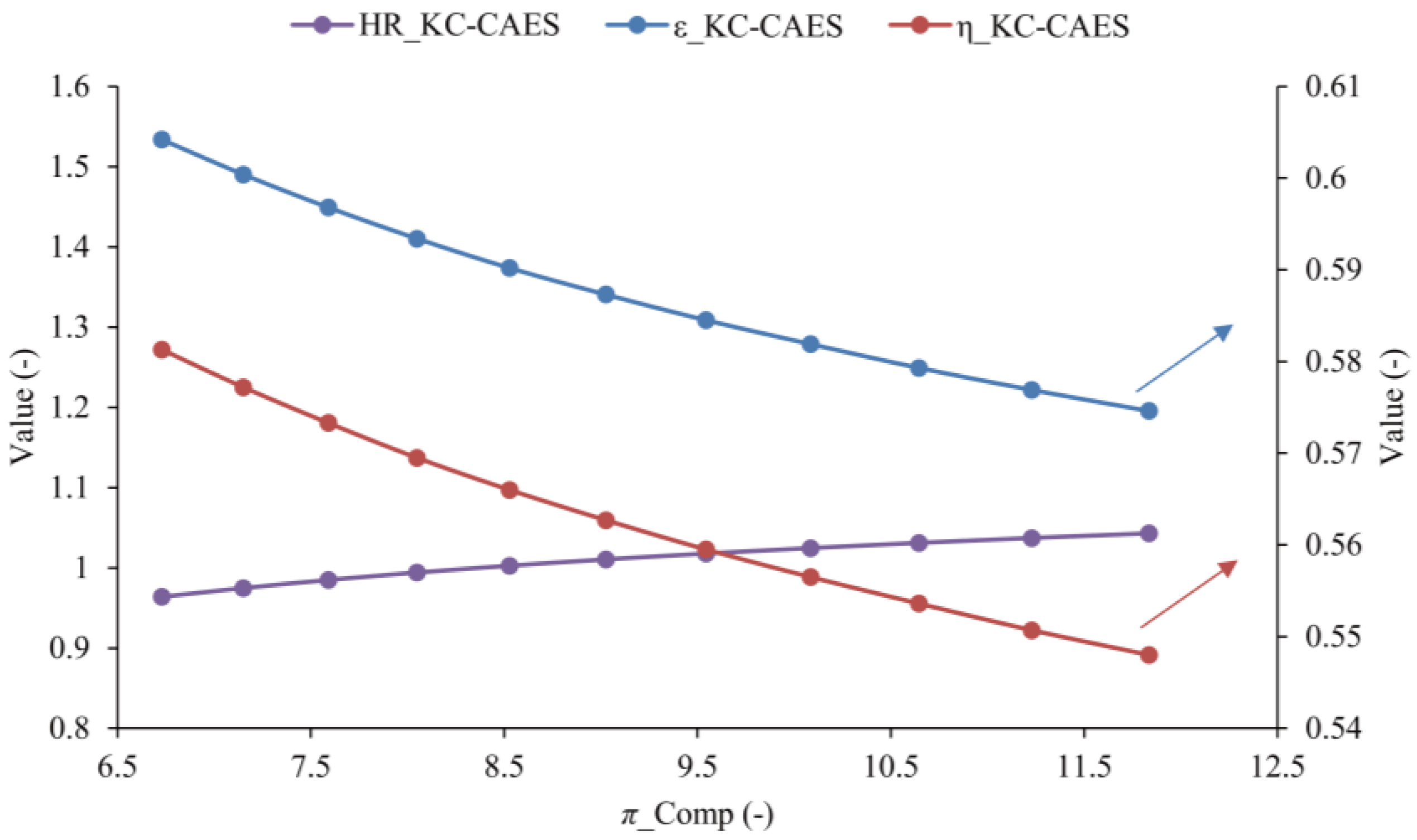

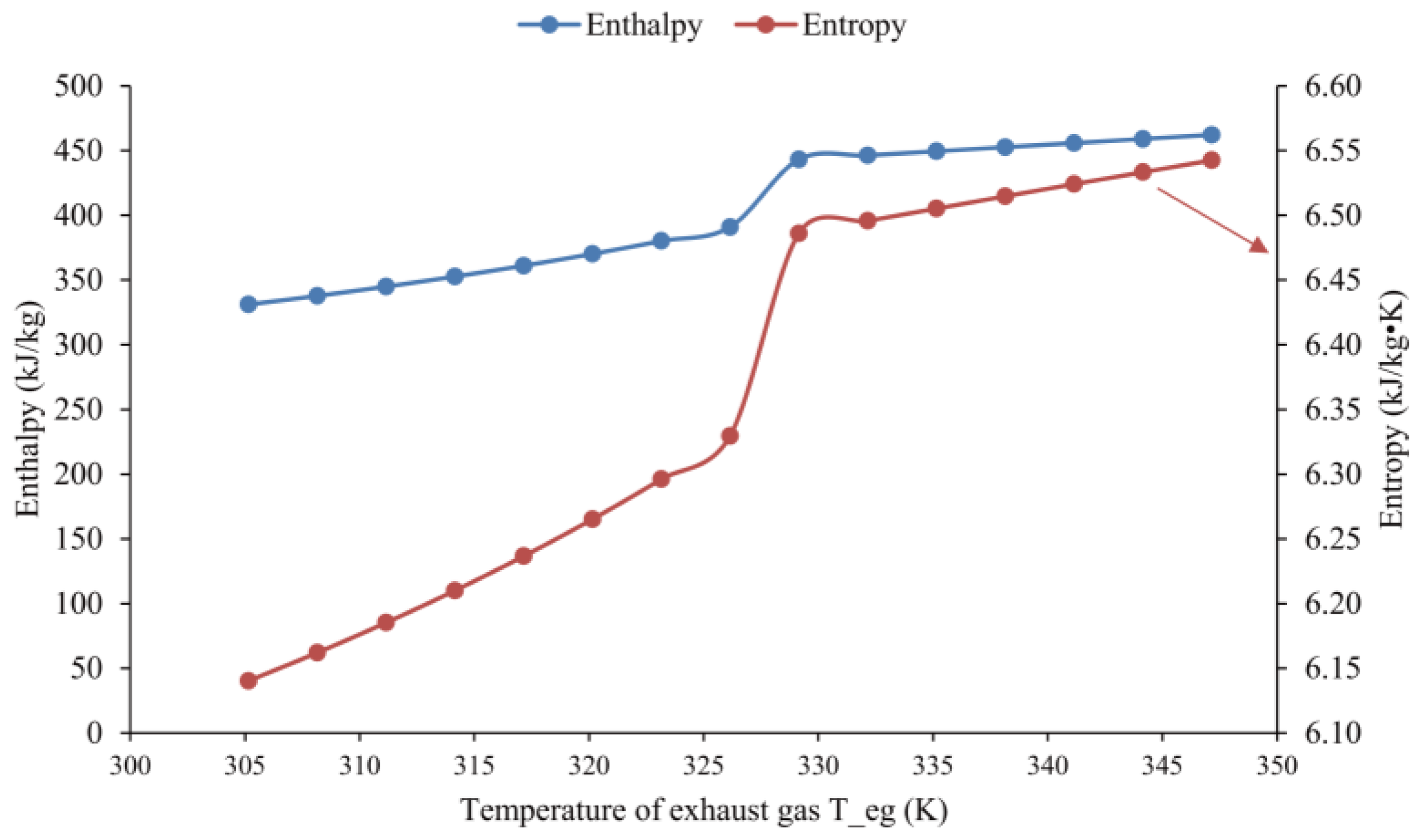



| Term | Unit | Value |
|---|---|---|
| Ambient temperature | K | 298.15 |
| Ambient pressure | MPa | 0.10 |
| Pinch temperature difference | K | 8 |
| Turbine isentropic efficiency | - | 0.9 |
| Compressor isentropic efficiency | - | 0.9 |
| Pump isentropic efficiency | - | 0.7 |
| Work solution concentration | - | 0.55 |
| Rich solution concentration | - | 0.80 |
| Basic solution concentration | - | 0.25 |
| Gas engine power efficiency | - | 0.42 |
| Rated air flow rate of compression | kg/s | 98.80 |
| Volume of air storage vessel | m3 | 30,000.00 |
| System | πComp | Teg (K) | Exergy Efficiency (%) | ICPP (k$/kW) |
|---|---|---|---|---|
| KC-CAES | 7.33 | 323 | 59.74 | 0.61 |
| ORC-CAES | 6.42 | 344 | 53.56 | 0.67 |
| System | Relative Exergy Efficiency (%) | Relative Round-Trip Efficiency (%) | Heat Recovery Cycle Efficiency (%) |
|---|---|---|---|
| KC-CAES | 27.32 | 27.35 | 20.5 |
| ORC-CAES | 16.83 | 16.89 | 11.7 |
© 2016 by the authors; licensee MDPI, Basel, Switzerland. This article is an open access article distributed under the terms and conditions of the Creative Commons Attribution (CC-BY) license (http://creativecommons.org/licenses/by/4.0/).
Share and Cite
Li, R.; Wang, H.; Yao, E.; Zhang, S. Thermo-Economic Comparison and Parametric Optimizations among Two Compressed Air Energy Storage System Based on Kalina Cycle and ORC. Energies 2017, 10, 15. https://doi.org/10.3390/en10010015
Li R, Wang H, Yao E, Zhang S. Thermo-Economic Comparison and Parametric Optimizations among Two Compressed Air Energy Storage System Based on Kalina Cycle and ORC. Energies. 2017; 10(1):15. https://doi.org/10.3390/en10010015
Chicago/Turabian StyleLi, Ruixiong, Huanran Wang, Erren Yao, and Shuyu Zhang. 2017. "Thermo-Economic Comparison and Parametric Optimizations among Two Compressed Air Energy Storage System Based on Kalina Cycle and ORC" Energies 10, no. 1: 15. https://doi.org/10.3390/en10010015





